Gain insights into the biblical significance of banners as symbols of divine protection, faith, and victory, revealing deeper spiritual truths.
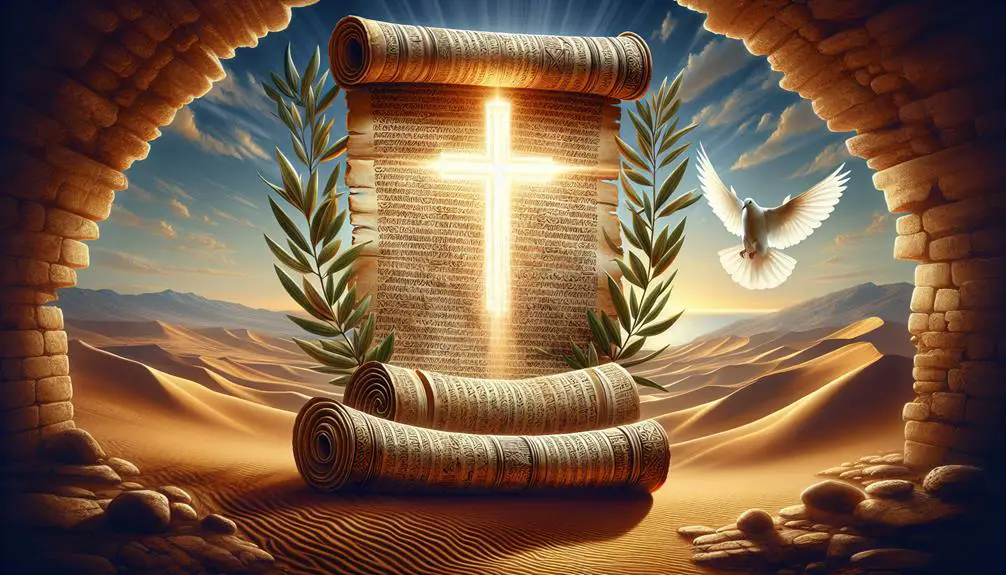
Meaning of Banner in the Bible
As the adage goes, 'A banner is worth a thousand words,' especially when you explore its profound meanings in the Bible. You'll find that banners aren't just pieces of cloth; they're powerful symbols representing God's presence, divine protection, and even celebration.
They held significant historical and military importance, reflecting the deep intertwining of faith and daily life in biblical times. As you explore the diverse roles banners played, from rallying points in battles to symbols of love and worship, you'll uncover layers of meaning that could transform your understanding of biblical narratives and perhaps, even your own life's battles.
What might these ancient symbols reveal to you about faith, protection, and celebration in your own journey?
Key Takeaways
- Banners in the Bible symbolize identity, unity, divine protection, and God's presence.
- They employ color and fabric symbolism to convey aspects of God's character and promises.
- Used in warfare, worship, and celebrations, banners signify divine sanction, holiness, and communal joy.
- Modern interpretations of biblical banners connect historical spiritual meanings with contemporary cultural and political expressions.
Historical Context of Banners
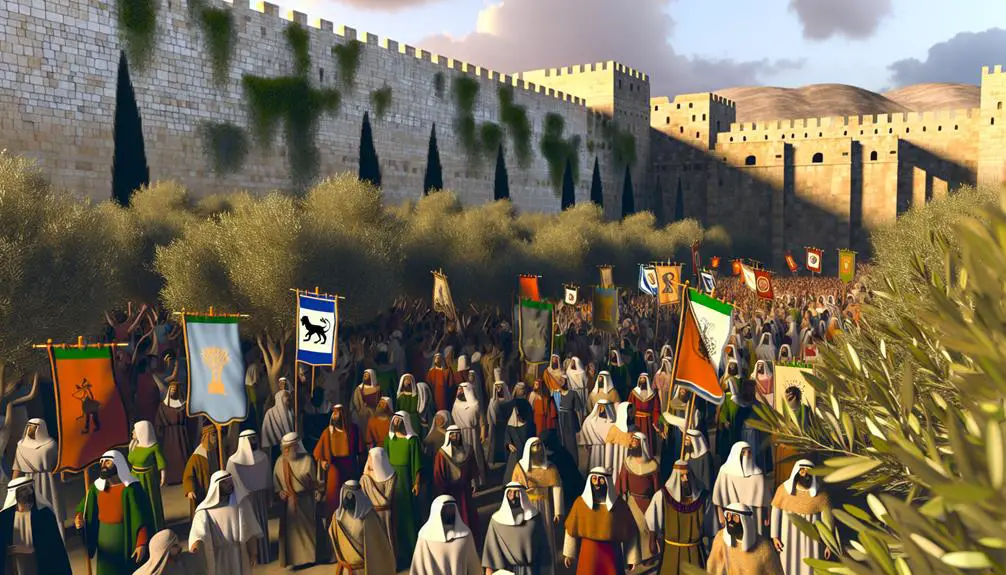
Why did ancient communities regard banners as significant symbols in various ceremonies and battles?
The answer lies not just in their symbolic representation but also in the meticulous care taken in their creation. Manufacturing methods were deeply intertwined with the cultural and technological capabilities of the time, reflecting a community's expertise and resources. Material choices, too, played a crucial role. Fabrics were selected for durability and visibility, often dyed in vibrant colors using natural pigments to stand out against the backdrop of the battlefield or the ceremonial ground. These materials weren't chosen at random; each had a specific significance, with certain colors and patterns denoting different clans, gods, or messages.
The methodical crafting of banners, from weaving the fabric to painting or embroidering symbols, was a skilled labor of love and devotion. This process ensured that banners weren't only visually striking but also imbued with cultural and spiritual meaning. Through these careful manufacturing methods and deliberate material choices, banners transcended their physical form to become powerful symbols of identity, unity, and divine protection, deeply embedded in the rituals and traditions of ancient communities.
Banners as Symbols of God's Presence
Throughout biblical history, banners often symbolized God's omnipresent guidance and protection for His people, serving as a tangible reminder of His unwavering support during pivotal moments. These flags weren't mere decorative pieces but held profound spiritual meanings, intricately woven into their fabric and colors.
The fabric and color of banners carried deep symbolic value, conveying messages of divine presence and promises. The meticulous choice of materials and hues revealed a rich tapestry of theological insights and spiritual truths. This methodical approach to understanding banners sheds light on how they functioned as more than physical objects but as vehicles of divine communication.
- Fabric Significance: The materials used for banners, such as linen or silk, were often chosen for their purity or richness, symbolizing the holiness and majesty of God. The quality and texture of the fabric spoke volumes about the reverence and adoration toward the Divine.
- Color Symbolism: Specific colors were employed to convey different aspects of God's character. For example, blue often represented divine revelation, while red symbolized sacrifice and redemption. This color symbolism allowed believers to visually grasp complex spiritual truths.
- Tangible Reminder: Banners served as a physical representation of God's promises, reminding the faithful of His presence and protection in every circumstance.
Military Significance in Scripture
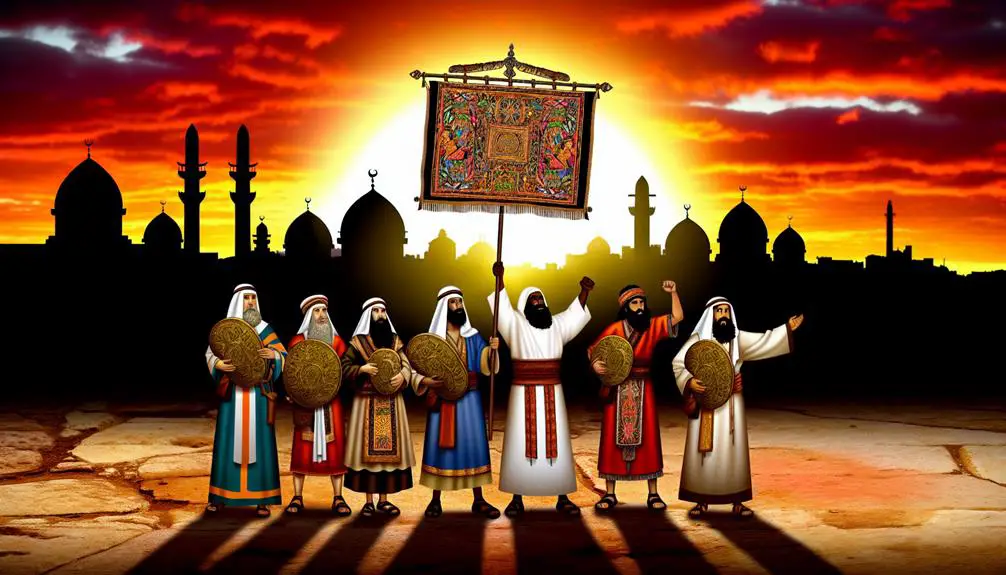
You'll find that banners held a critical role in biblical narratives, particularly within the context of military engagements. They served not only as symbolic warfare emblems, embodying the divine endorsement or protection, but also as rallying points for troops during battles.
This dual function underscores their importance in both spiritual and tactical dimensions within scripture.
Symbolic Warfare Emblems
In biblical narratives, banners often serve as symbolic warfare emblems, encapsulating the divine sanction of military endeavors and the collective identity of combatants. These emblems aren't just arbitrary; they're imbued with deep meanings. Color symbolism and fabric types play crucial roles in their significance.
- Color Symbolism: Each color on the banners signifies a specific attribute or divine association. For example, red might symbolize sacrifice or courage, whereas blue could represent divine revelation or the heavens.
- Fabric Types: The choice of fabric, whether linen, wool, or a blend, often has spiritual connotations, reflecting purity, divinity, or the blending of human and divine efforts in warfare.
- Divine Sanction: Banners signal God's approval of the battle, offering both motivation and legitimacy to the warriors' cause.
Rallying Point Functions
Many biblical accounts demonstrate how banners functioned as rallying points, significantly influencing the outcome of military engagements by providing a visual focal point for troops. This strategic use underscores the banners' dual role in political symbolism and the reinforcement of social identity among combatants.
By embodying both the divine mandate and communal ethos, these banners weren't mere symbols but pivotal tools in warfare strategy. They encapsulated the collective will and purpose, guiding soldiers towards a unified objective. In this context, the visual prominence of banners fostered a sense of belonging and determination, essential for maintaining morale and discipline in the face of adversity.
Thus, the military significance of banners in scripture extends beyond their physical presence, embedding deeper layers of political and social connotations.
Banners Reflecting Divine Protection
Exploring the Bible reveals that banners often symbolize divine protection, guiding and sheltering believers through their spiritual journeys. This concept is vividly illustrated through various narratives and verses, where the presence of a banner signifies the omnipresent safeguarding hand of the divine over its people. The materials and artistic depictions involved in these banners aren't mere decorations but carry deep theological significance.
- Artistic Depictions: These often include symbolic imagery such as the Lion of Judah or the burning bush, serving as visual reminders of God's protection and presence.
- Fabric Materials: The choice of materials, ranging from linen to silk, signifies purity, divinity, and the sacred bond between God and His people.
- Spiritual Symbolism: Every stitch and color choice is imbued with meaning, from divine guidance to the promise of protection against spiritual warfare.
Analyzing these elements methodically, it becomes clear that banners in the Bible are far more than historical artifacts. They are, in essence, tangible expressions of divine protection, meticulously designed to convey spiritual truths and offer comfort to believers. Through these banners, the faithful are reminded of the ever-present watchful eye of their protector, guiding them through life's tumultuous journey.
Celebratory Uses in Biblical Times
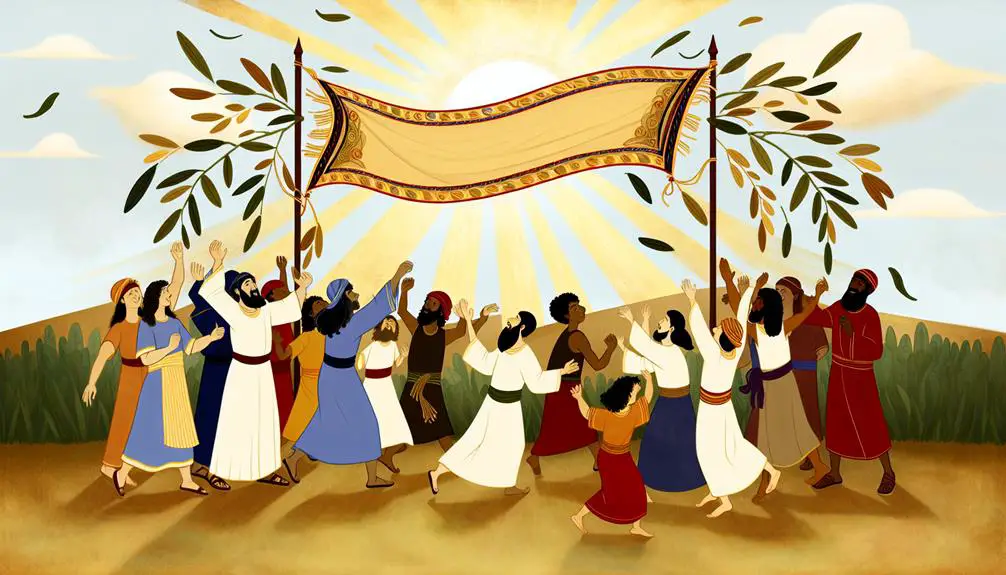
Shifting focus to the celebratory functions, banners in Biblical times served not only as symbols of divine protection but also played a pivotal role in religious and communal celebrations. These artifacts, crafted with meticulous attention to fabric materials and design techniques, underscored the deep-seated ceremonial aspects of ancient societies.
You'd find that the choice of fabric materials wasn't arbitrary. Linen, known for its durability and purity, was often the preferred material, symbolizing the sanctity of the events they graced. This choice wasn't merely functional but deeply symbolic, intertwining material properties with spiritual significances.
Moreover, the design techniques employed in creating these banners were equally significant. Embroidery, often in gold or scarlet threads, wasn't just an aesthetic choice but a narrative tool. Through intricate patterns and symbols, these banners told stories, celebrated victories, and proclaimed divine messages. The craftsmanship involved was a testament to the skill and devotion of the artisans, who imbued these objects with both beauty and meaning.
In this light, banners were more than mere decorations. They were integral to the fabric of Biblical celebrations, encapsulating both the joy and the solemnity of these occasions through their material and design.
The Banner of Love
In the context of Biblical narratives, the 'Banner of Love' symbolizes God's enduring commitment to His people, serving as a profound reminder of divine affection and protection. This notion is deeply ingrained in the fabric of biblical text, highlighting a relationship that transcends mere obligation. Instead, it mirrors a covenant woven with threads of unwavering love and care.
The use of romantic imagery in this context isn't merely decorative but serves a crucial interpretive role. It paints a vivid picture of the depth and intensity of God's love, likening it to the most passionate human relationships. This analogy isn't just poetic but is methodically used to underscore the personal nature of the divine-human relationship.
Festive decorations, often mentioned alongside banners in the Bible, further enrich this imagery. They don't just signify celebration but also mark the recognition and acknowledgment of this divine love that envelops and protects.
- Romantic imagery in biblical narratives underscores the intensity and depth of God's love.
- Festive decorations alongside banners symbolize celebration and recognition of divine affection.
- The 'Banner of Love' serves as a metaphor for God's unwavering commitment and protection, illustrating a deeply personal relationship with His people.
Banners in Worship and Praise

Building on the profound symbolism of the 'Banner of Love', banners in worship and praise serve a distinct but complementary role, reflecting the community's collective response to divine love through ceremonial expressions. These banners, intricately designed and meticulously crafted, are not merely decorative elements. They embody the spiritual fervor and doctrinal beliefs of the congregation, utilizing various fabric types and design techniques to communicate their sacred messages.
Fabric Types |
Design Techniques |
|---|---|
Silk |
Embroidery |
Velvet |
Appliqué |
Linen |
Screen Printing |
Polyester |
Hand Painting |
Silk and velvet, with their luxurious textures, are often chosen for their aesthetic appeal and the sense of reverence they inspire, while linen and polyester offer durability and versatility for outdoor or frequent use. Techniques like embroidery and appliqué allow for the creation of detailed and symbolic imagery, whereas screen printing and hand painting are employed for their ability to produce vivid colors and intricate patterns. Through these materials and methods, banners in worship and praise transcend mere craftsmanship, becoming profound expressions of faith and devotion.
Modern Interpretations and Applications
You encounter banners in various facets of contemporary life. They serve as potent symbols bridging the past with the present.
Analyzing their symbolic uses today reveals how they offer spiritual guidance and reflect broader cultural influences.
This exploration not only enriches your understanding of biblical references but also highlights their enduring relevance and application in modern contexts.
Symbolic Uses Today
While the ancient use of banners held deep symbolic significance in biblical times, today's interpretations and applications often reflect a broader spectrum of meanings and purposes. The evolution of banner symbolism can be observed in various domains, including advertising trends and political campaigns. These modern usages, while divergent from their historical origins, still serve to communicate powerful messages, rally support, and signify identity or affiliation.
- Advertising Trends: Banners are pivotal in branding and promotional strategies, encapsulating core messages in visually compelling formats.
- Political Campaigns: They encapsulate ideologies and foster community among supporters, serving as rallying points during events.
- Community Events: Banners symbolize unity and celebration, marking gatherings and festivals with distinctive visual cues.
Spiritual Guidance Interpretations
In contemporary contexts, banners serve as beacons for spiritual guidance, offering interpretations and applications that transcend traditional religious boundaries. Through personal meditation, individuals engage with these symbols to uncover deeper meanings and insights, fostering a unique, introspective relationship with their spirituality.
This personal journey is complemented by community interpretation, where collective wisdom and shared values are harnessed to provide a broader understanding of the banner's significance. Methodically, this dual approach enables a thorough exploration of spiritual symbols, enriching both individual and communal spiritual experiences.
Analytically, it's evident that the integration of personal meditation and community interpretation with banners not only revitalizes ancient traditions but also adapts them to suit modern spiritual quests, thereby maintaining their relevance and potency in guiding contemporary spiritual paths.
Cultural Influence Analysis
Numerous cultural movements have reinterpreted banners within modern contexts, revealing their enduring influence on societal values and spiritual practices. Banners carry deep symbolic meanings, often acting as a bridge between historical traditions and contemporary expressions. Their utilization in modern settings underscores the dynamic interplay between art influences and political implications, shaping public discourse and cultural identity.
- Art influences: Banners serve as a canvas for artistic expression, channeling historical and spiritual messages into visual forms that resonate with contemporary audiences.
- Political implications: They're pivotal in political movements, embodying ideals and uniting individuals around shared causes.
- Spiritual practices: Modern spiritual communities often adopt banners to symbolize faith, continuity, and communal identity, linking them to their scriptural roots while embracing present-day relevance.
Frequently Asked Questions
How Do Different Bible Translations Vary in Their Depiction and Interpretation of "Banners"?
When you dive into translation analysis, you'll notice interpretative variations in how 'banners' are depicted across different Bible translations. These discrepancies arise from the complex process of translating ancient texts into modern languages.
Each translation brings its own nuances, shaped by linguistic choices and cultural contexts. This results in a spectrum of interpretations, providing you with a rich, layered understanding of the text's original meaning and its transformation over time.
Are There Any Lost or Forgotten Banner Traditions Mentioned in Apocryphal or Non-Canonical Texts?
Yes, there are lost or forgotten banner traditions mentioned in apocryphal or non-canonical texts. These texts often contain apocryphal symbols and show considerable textual variations from canonical scriptures.
How Have Different Cultures Throughout History Adopted or Adapted Biblical Banner Concepts Into Their Own Religious or Secular Practices?
Throughout history, you'll find that cultures have woven biblical banner concepts into their fabric, much like a standard leading an army into battle. These banners, originally spiritual symbols, have evolved into military standards and festival decorations.
This adaptation showcases a methodical blend of the sacred and the secular, illustrating how deeply religious imagery can influence societal norms and practices, from solemn religious processions to the vibrant flags fluttering at cultural festivals.
Can the Concept of Banners in the Bible Be Linked to Any Specific Archaeological Findings, Such as Artifacts or Inscriptions?
You're diving into whether archaeological discoveries tie back to banner symbolism and military significance found in historical texts. By analyzing artifacts and inscriptions, you're looking for concrete evidence linking these objects to the concepts of banners.
This scholarly approach requires methodically sifting through archaeological findings to unearth any direct connections. Your focus is on how these tangible pieces can illuminate our understanding of the symbolic and military roles banners played in ancient societies.
What Role Do Banners Play in Contemporary Christian Denominations That Emphasize a Literal Interpretation of the Bible?
Ironically, you mightn't see banners parading down your local supermarket aisle, but in contemporary Christian denominations valuing literal biblical interpretations, they're front and center.
Banner symbolism isn't just about colorful fabric; it's deeply woven into worship practices, embodying divine messages and communal identity.
Analyzing these traditions reveals a methodical approach to faith expression, where each banner hoisted isn't merely decorative but a profound declaration of belief and an act of collective worship.
Conclusion
In sum, banners in the Bible aren't just pieces of fabric; they're rich tapestries woven with divine symbolism. They've served as God's fingerprints across the sands of time, signaling His presence, protection, and promises.
Whether fluttering in ancient battlefields or adorning places of worship, these banners have always been more than meets the eye, embodying love, victory, and divine favor. Today, they beckon us to remember and revere the enduring, multifaceted relationship between the divine and the devout.

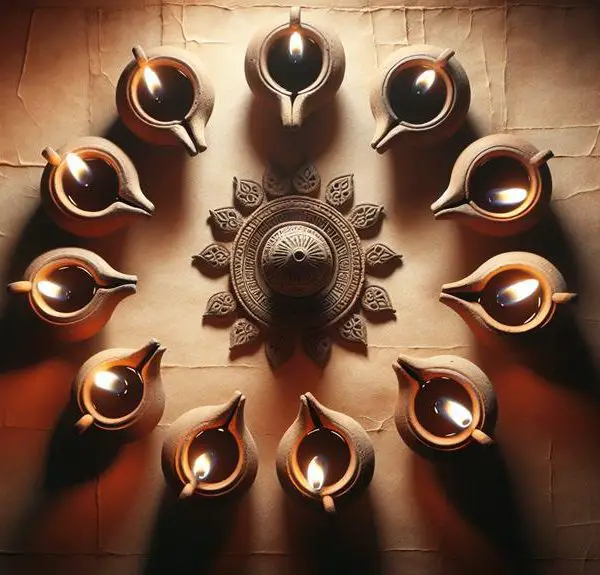

Sign up